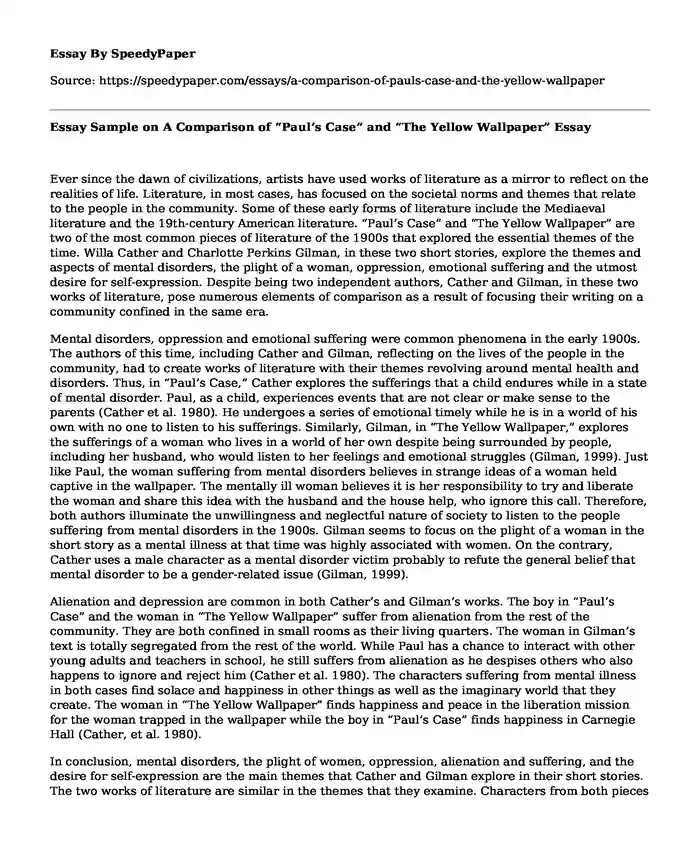
| Essay type: | Compare and contrast |
| Categories: | Mental disorder The Yellow Wallpaper Writers Comparative literature |
| Pages: | 3 |
| Wordcount: | 730 words |
Ever since the dawn of civilizations, artists have used works of literature as a mirror to reflect on the realities of life. Literature, in most cases, has focused on the societal norms and themes that relate to the people in the community. Some of these early forms of literature include the Mediaeval literature and the 19th-century American literature. “Paul’s Case” and “The Yellow Wallpaper” are two of the most common pieces of literature of the 1900s that explored the essential themes of the time. Willa Cather and Charlotte Perkins Gilman, in these two short stories, explore the themes and aspects of mental disorders, the plight of a woman, oppression, emotional suffering and the utmost desire for self-expression. Despite being two independent authors, Cather and Gilman, in these two works of literature, pose numerous elements of comparison as a result of focusing their writing on a community confined in the same era.
Mental disorders, oppression and emotional suffering were common phenomena in the early 1900s. The authors of this time, including Cather and Gilman, reflecting on the lives of the people in the community, had to create works of literature with their themes revolving around mental health and disorders. Thus, in “Paul’s Case,” Cather explores the sufferings that a child endures while in a state of mental disorder. Paul, as a child, experiences events that are not clear or make sense to the parents (Cather et al. 1980). He undergoes a series of emotional timely while he is in a world of his own with no one to listen to his sufferings. Similarly, Gilman, in “The Yellow Wallpaper,” explores the sufferings of a woman who lives in a world of her own despite being surrounded by people, including her husband, who would listen to her feelings and emotional struggles (Gilman, 1999). Just like Paul, the woman suffering from mental disorders believes in strange ideas of a woman held captive in the wallpaper. The mentally ill woman believes it is her responsibility to try and liberate the woman and share this idea with the husband and the house help, who ignore this call. Therefore, both authors illuminate the unwillingness and neglectful nature of society to listen to the people suffering from mental disorders in the 1900s. Gilman seems to focus on the plight of a woman in the short story as a mental illness at that time was highly associated with women. On the contrary, Cather uses a male character as a mental disorder victim probably to refute the general belief that mental disorder to be a gender-related issue (Gilman, 1999).
Alienation and depression are common in both Cather’s and Gilman’s works. The boy in “Paul’s Case” and the woman in “The Yellow Wallpaper” suffer from alienation from the rest of the community. They are both confined in small rooms as their living quarters. The woman in Gilman’s text is totally segregated from the rest of the world. While Paul has a chance to interact with other young adults and teachers in school, he still suffers from alienation as he despises others who also happens to ignore and reject him (Cather et al. 1980). The characters suffering from mental illness in both cases find solace and happiness in other things as well as the imaginary world that they create. The woman in “The Yellow Wallpaper” finds happiness and peace in the liberation mission for the woman trapped in the wallpaper while the boy in “Paul’s Case” finds happiness in Carnegie Hall (Cather, et al. 1980).
In conclusion, mental disorders, the plight of women, oppression, alienation and suffering, and the desire for self-expression are the main themes that Cather and Gilman explore in their short stories. The two works of literature are similar in the themes that they examine. Characters from both pieces suffer from mental disorders, alienation from the community, oppression, and lack of self-expression. However, they create a world of their own and find peace in different things that are unexplainable through common sense. Despite the many similarities, the two texts differ in the theme of the plight of women.
Reference
Cather, W., Jackson, L., Cowen, R., & Roberts, E. (1980). Paul's case. Coronet Films & Video.
Gilman, C. P. (1999). The yellow wallpaper. Project Gutenberg.
Cite this page
Essay Sample on A Comparison of "Paul's Case" and "The Yellow Wallpaper". (2023, Oct 10). Retrieved from https://speedypaper.net/essays/a-comparison-of-pauls-case-and-the-yellow-wallpaper
Request Removal
If you are the original author of this essay and no longer wish to have it published on the SpeedyPaper website, please click below to request its removal:
- Literary Analysis on Death of a Salesman, Free Essay Example
- Grendel's Mother - Book Review Essay Example
- Free Essay: Dark Innocent Sides of the World in William Blake's Poems
- Questions by Rachael Richardson - Poem Analysis Essay Sample
- Free Essay with a Critical Analysis of the Book Night by Elie Wiesel
- Free Essay. Reflection on an Action Research
- Paper Example: Why I Will Teach
Popular categories




